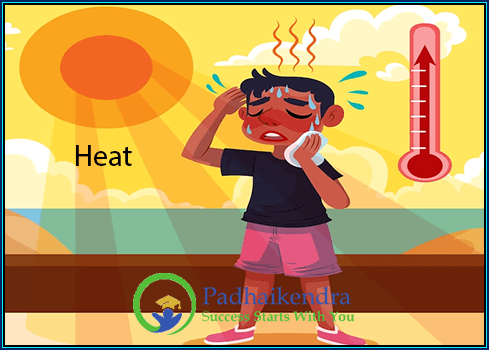Definition of Heat
Heat is a form of energy that is transferred from one body or system to another as a result of a difference in temperature. It flows from a body at a higher temperature to a body at a lower temperature, until both bodies reach thermal equilibrium and have the same temperature.
Heat transfer occurs in three main ways: conduction, convection, and radiation. In conduction, heat is transferred through a material by direct contact between the particles of the material. In convection, heat is transferred by the movement of fluids or gases. In radiation, heat is transferred through electromagnetic waves.
Units of Heat
The unit of measurement for heat is the joule (J), although other units like calories (cal) or British thermal units (BTU) are also commonly used. Heat is also related to the concept of specific heat, which is the amount of heat required to raise the temperature of a given substance by a certain amount.
Heat plays an important role in many natural phenomena and technological applications, including weather patterns, cooking, power generation, and heating and cooling systems. Understanding heat transfer and the behavior of heat is essential in many fields, including thermodynamics, physics, and engineering.
Importance of Heat in Everyday Life
Heat is a vital form of energy that influences numerous aspects of our daily lives. Here are some key areas where heat plays a significant role:
Cooking and Food Preparation
 Heat is essential for cooking food. Whether it’s boiling, frying, baking, or grilling, the application of heat helps in transforming raw ingredients into delicious meals. Different cooking techniques utilize heat to achieve specific textures, flavors, and safety standards.
Heat is essential for cooking food. Whether it’s boiling, frying, baking, or grilling, the application of heat helps in transforming raw ingredients into delicious meals. Different cooking techniques utilize heat to achieve specific textures, flavors, and safety standards.
Climate Control and Heating Systems
 Heating and cooling systems in our homes, offices, and vehicles rely on heat transfer to maintain comfortable temperatures. Furnaces, radiators, air conditioners, and heat pumps utilize the principles of heat transfer to either warm or cool the air, ensuring our indoor environments are pleasant throughout the year.
Heating and cooling systems in our homes, offices, and vehicles rely on heat transfer to maintain comfortable temperatures. Furnaces, radiators, air conditioners, and heat pumps utilize the principles of heat transfer to either warm or cool the air, ensuring our indoor environments are pleasant throughout the year.
Power Generation
 Heat is a crucial component in power generation. Many power plants, such as those fueled by coal, natural gas, or nuclear energy, utilize heat to produce steam. This steam then drives turbines, which generate electricity. Even renewable energy sources like solar power rely on capturing and converting heat energy from the Sun.
Heat is a crucial component in power generation. Many power plants, such as those fueled by coal, natural gas, or nuclear energy, utilize heat to produce steam. This steam then drives turbines, which generate electricity. Even renewable energy sources like solar power rely on capturing and converting heat energy from the Sun.
Weather Patterns
 The uneven heating of the Earth’s surface plays a significant role in shaping weather patterns. The heat from the Sun causes air to warm, expand, and rise, creating areas of low pressure. This leads to the formation of winds, clouds, and atmospheric circulation, which in turn influence weather conditions worldwide.
The uneven heating of the Earth’s surface plays a significant role in shaping weather patterns. The heat from the Sun causes air to warm, expand, and rise, creating areas of low pressure. This leads to the formation of winds, clouds, and atmospheric circulation, which in turn influence weather conditions worldwide.
Industrial Processes
 Heat is employed in various industrial processes, including metal smelting, glass manufacturing, chemical reactions, and material shaping. These processes often require specific temperatures to achieve desired outcomes, such as melting, molding, or chemical transformations.
Heat is employed in various industrial processes, including metal smelting, glass manufacturing, chemical reactions, and material shaping. These processes often require specific temperatures to achieve desired outcomes, such as melting, molding, or chemical transformations.
Heat, as a form of energy transfer, is essential for numerous aspects of our lives. Whether it’s cooking our meals, maintaining comfortable temperatures, generating electricity, shaping materials, or understanding weather patterns, heat plays a vital role.





